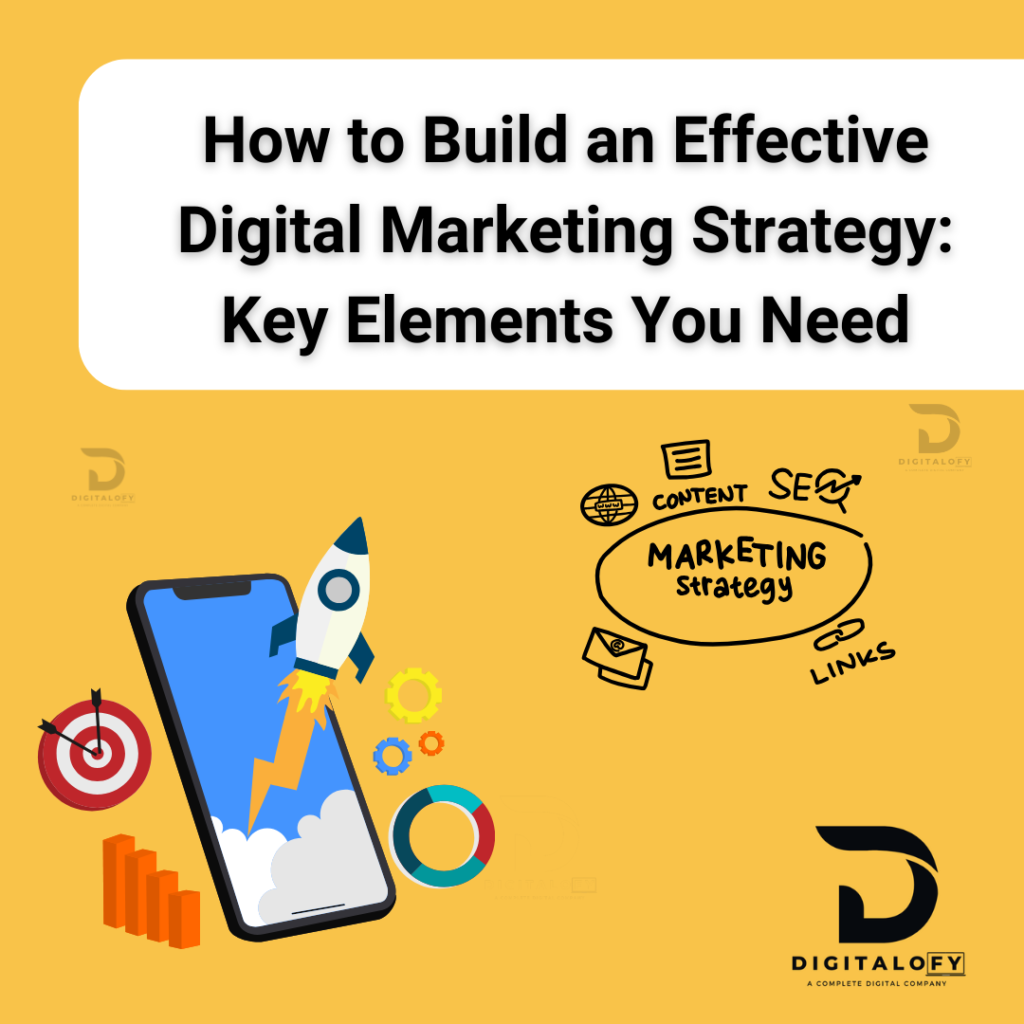How to Build an Effective Digital Marketing Strategy: Key Elements You Need
In today’s digital-first world, having a well-defined digital marketing strategy is no longer optional—it’s essential. Whether you’re a small business owner, a marketer, or an entrepreneur, learning how to build an effective digital marketing strategy can help you reach your target audience, boost brand awareness, and drive conversions. But how do you create a strategy that delivers results? In this blog, we’ll walk you through the key elements you need and provide a step-by-step guide to building a strategy that works.
Why Do You Need a Digital Marketing Strategy?
Before diving into the steps, let’s understand why a digital marketing strategy is crucial:
- Clear Direction: A strategy provides a roadmap for your marketing efforts.
- Better ROI: It ensures your budget is spent on the right channels and tactics.
- Competitive Edge: A well-planned strategy helps you stand out in a crowded market.
- Measurable Results: It allows you to track progress and optimize campaigns.
Without a strategy, your efforts may lack focus, leading to wasted time, money, and resources.
Step-by-Step Guide to Building an Effective Digital Marketing Strategy

1. Define Your Goals
The first step in learning how to build an effective digital marketing strategy is setting clear, measurable goals. Ask yourself:
- What do you want to achieve? (e.g., increase website traffic, generate leads, boost sales)
- Who is your target audience?
- What is your timeline?
Use the SMART framework (Specific, Measurable, Achievable, Relevant, Time-bound) to define your goals. For example:
- “Increase website traffic by 30% in the next 6 months.”
- “Generate 500 new leads per month through social media campaigns.”
2. Understand Your Target Audience

Knowing your audience is the foundation of any successful digital marketing strategy. Create detailed buyer personas to understand their demographics, preferences, pain points, and online behavior. Tools like Google Analytics, social media insights, and customer surveys can help you gather this data.
Key questions to ask:
- Who is your ideal customer?
- What platforms do they use?
- What challenges do they face?
- What type of content do they engage with?
3. Conduct a Competitor Analysis
Analyzing your competitors can provide valuable insights into what works and what doesn’t in your industry. Identify their strengths, weaknesses, and the strategies they’re using. Tools like SEMrush, Ahrefs, and SpyFu can help you analyze their SEO, PPC, and content strategies.
Focus on:
- Their top-performing content.
- Social media engagement.
- Paid advertising tactics.
- Gaps you can fill to differentiate your brand.
4. Choose the Right Digital Marketing Channels
Not all channels will be relevant to your business. Based on your audience and goals, select the platforms that will deliver the best results. Common digital marketing channels include:
- Search Engine Optimization (SEO): Optimize your website to rank higher on search engines.
- Pay-Per-Click Advertising (PPC): Run targeted ads on Google, Facebook, or LinkedIn.
- Social Media Marketing: Engage with your audience on platforms like Instagram, Twitter, or TikTok.
- Email Marketing: Nurture leads and retain customers through personalized emails.
- Content Marketing: Create valuable content to attract and engage your audience.
5. Create a Content Plan
Content is the backbone of digital marketing. Develop a content strategy that aligns with your goals and resonates with your audience. Include a mix of:
- Blog posts
- Videos
- Infographics
- Case studies
- Social media posts
Use tools like Google Keyword Planner and AnswerThePublic to find topics your audience is searching for.
- Hostinger Coupon Code: Unlock Big Savings on Hosting & Domains in 2025
- How to Build an Effective Digital Marketing Strategy: Key Elements You Need
- The Ultimate Guide to Digital Marketing for Small Businesses in 2025
- Unlock Your Business’s Potential with a Stellar Website 🌟 | Expert Web Design Services
6. Optimize for SEO
SEO is critical for driving organic traffic to your website. Focus on:
- Keyword Research: Identify high-volume, low-competition keywords related to your business.
- On-Page SEO: Optimize title tags, meta descriptions, headers, and images.
- Technical SEO: Improve site speed, mobile-friendliness, and site structure.
- Backlinks: Build high-quality backlinks to boost your domain authority.
7. Leverage Social Media
Social media is a powerful tool for building brand awareness and engaging with your audience.
- Post consistently and use a mix of content types (videos, images, polls, etc.).
- Engage with your followers by responding to comments and messages.
- Use paid social ads to reach a broader audience.
8. Monitor and Analyze Performance
Tracking your progress is essential to understand what’s working and what’s not. Use tools like Google Analytics, HubSpot, or Hootsuite to monitor key metrics such as:
- Website traffic
- Conversion rates
- Click-through rates (CTR)
- Social media engagement
- ROI on ad spend
Regularly review your data and adjust your strategy accordingly.
9. Test and Optimize
Digital marketing is not a one-time effort. Continuously test different tactics, such as A/B testing for ads, email subject lines, or landing pages. Use the insights gained to refine your strategy and improve results.
Key Elements of an Effective Digital Marketing Strategy
- Clear Goals and KPIs: Define what success looks like and how you’ll measure it.
- Audience-Centric Approach: Tailor your strategy to meet the needs of your target audience.
- Integrated Channels: Use a mix of channels to reach your audience at different touchpoints.
- High-Quality Content: Create valuable, engaging content that solves your audience’s problems.
- Data-Driven Decisions: Use analytics to guide your strategy and optimize performance.
- Consistency: Maintain a consistent brand voice and posting schedule across all platforms.
Tips for Growth in Digital Marketing
- Stay Updated: Digital marketing trends change rapidly. Stay informed about the latest tools, algorithms, and best practices.
- Invest in Automation: Use tools like email automation, social media schedulers, and CRM software to save time and improve efficiency.
- Focus on User Experience: Ensure your website is easy to navigate, mobile-friendly, and fast-loading.
- Build Relationships: Engage with your audience and build trust through personalized interactions.
Conclusion
Learning how to build an effective digital marketing strategy requires careful planning, execution, and continuous optimization. By following the steps outlined in this guide, you can create a strategy that drives growth, engages your audience, and delivers measurable results. Remember, the key to success lies in understanding your audience, choosing the right channels, and consistently delivering value.
Start implementing these strategies today, and watch your business thrive in the digital landscape!
Start implementing these strategies today, and watch your business thrive in the digital landscape!

